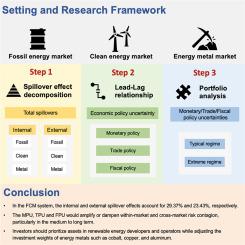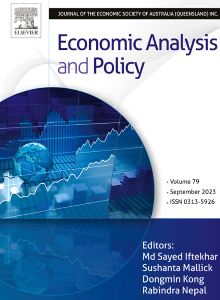Internal and external risk spillovers in energy and metal markets: the role of economic policy uncertainties
IF 8.7
2区 经济学
Q1 ECONOMICS
引用次数: 0
Abstract
Economic policy uncertainty has intensified volatility in energy markets and facilitated the spread of cross-market risks. Notably, metals play an indispensable role as a critical underpinning of clean energy technologies throughout the energy transition process. Given this, we employ the time-varying parameter vector autoregressive (TVP-VAR) connectedness decomposition method to calculate spillover effects within and across the fossil energy, clean energy, and energy metal markets (the FCM system). On this basis, we apply the wavelet coherence model to examine the lead-lag relationship of monetary policy uncertainty (MPU), trade policy uncertainty (TPU) and fiscal policy uncertainty (FPU) on spillovers. Finally, we develop portfolio strategies for the FCM system under different uncertainty regimes. Our main findings are as follows. First, internal (within-market) and external (cross-market) spillover effects accounted for 29.37 % and 23.42 % respectively. Renewable energy developers and operators emerge as the largest net transmitter, while cobalt is the largest net receiver. Additionally, spillovers exhibit significant time-varying characteristics and heightened sensitivity during crisis periods. Second, MPU, TPU and FPU amplify or dampen both internal and external risk spillovers, particularly in the medium to long term, with the clean energy market bing more sensitive to these uncertainties. Third, investors should overweight assets linked to renewable-energy developers and operators and dynamically adjust holdings of energy metals such as cobalt, copper, and aluminum in response to policy uncertainty conditions to achieve optimal risk diversification. Our findings provide insights for countries to improve institutional mechanisms and policy measures for the low-carbon energy transition.

能源和金属市场内部和外部风险溢出:经济政策不确定性的作用
经济政策的不确定性加剧了能源市场的波动,促进了跨市场风险的扩散。值得注意的是,在整个能源转型过程中,金属作为清洁能源技术的关键基础发挥着不可或缺的作用。鉴于此,我们采用时变参数向量自回归(TVP-VAR)连通性分解方法来计算化石能源、清洁能源和能源金属市场(FCM系统)内部和之间的溢出效应。在此基础上,运用小波相干模型分析了货币政策不确定性(MPU)、贸易政策不确定性(TPU)和财政政策不确定性(FPU)对溢出效应的前滞后关系。最后,我们为FCM系统在不同的不确定性下制定了投资组合策略。我们的主要发现如下。第一,内部(市场内)和外部(跨市场)溢出效应分别占29.37%和23.42%。可再生能源开发商和运营商成为最大的净发射器,而钴是最大的净接收器。此外,溢出效应在危机时期表现出显著的时变特征和高度敏感性。其次,MPU、TPU和FPU会放大或抑制内外部风险溢出,尤其是中长期风险溢出,清洁能源市场对这些不确定性更为敏感。第三,投资者应增持与可再生能源开发商和运营商相关的资产,并根据政策不确定性动态调整钴、铜和铝等能源金属的持有量,以实现最佳的风险分散。我们的研究结果为各国完善低碳能源转型的体制机制和政策措施提供了启示。
本文章由计算机程序翻译,如有差异,请以英文原文为准。
求助全文
约1分钟内获得全文
求助全文
来源期刊

Economic Analysis and Policy
ECONOMICS-
CiteScore
9.80
自引率
9.20%
发文量
231
审稿时长
93 days
期刊介绍:
Economic Analysis and Policy (established 1970) publishes articles from all branches of economics with a particular focus on research, theoretical and applied, which has strong policy relevance. The journal also publishes survey articles and empirical replications on key policy issues. Authors are expected to highlight the main insights in a non-technical introduction and in the conclusion.
 求助内容:
求助内容: 应助结果提醒方式:
应助结果提醒方式:


